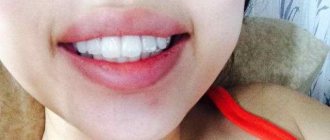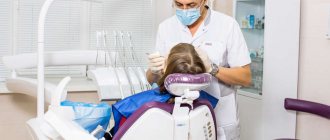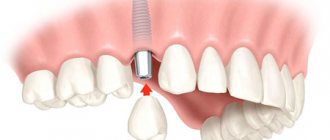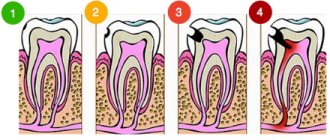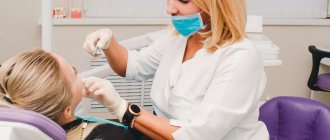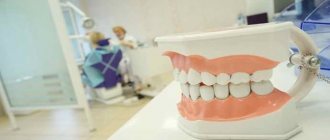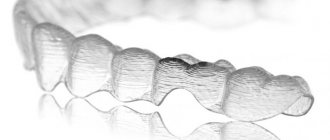Today, orthopedic doctors have modern materials and technologies that make it possible to restore damaged teeth to their natural appearance and maintain their health for many years. However, despite the important role of orthopedics in dental practice, it should be noted that when restoring damaged teeth and correcting jaw anomalies, the condition of the whole organism must be taken into account. The fact is that pathological processes in the oral cavity are often associated not only with external factors, but also with disruption of the functioning of internal organs. For example, insufficient nutrition of the tooth and surrounding tissues may be due to the presence of diseases of the gastrointestinal tract. Conversely, poor quality chewing leads to digestive problems. Therefore, without an integrated approach, orthopedic treatment may be ineffective.
Description of orthopedic dentistry technology
The main task performed by orthopedic dental prosthetics services is to straighten the dentition and eliminate other deformations that affect the asymmetry of the jaw.
Orthopedic treatment and dental prosthetics in dentistry also includes services for the following tasks and works:
- correction of pathology of jaw parameters;
- correction of incorrect position of the jaw rows;
- treatment of dental arch pathologies;
- elimination of deformation of individual teeth.
Orthopedic dentistry for prosthetics provides an individual approach to the work of an orthopedic dentist for each patient. The production of dentures for teeth is carried out taking into account not only the functional side, but also the aesthetic one. Thus, installed dentures are almost impossible to distinguish from natural teeth.
Implantation is a modern dental orthopedics service
The implant is a titanium rod that is designed to be implanted into the jaw bone tissue. It serves as the basis for artificial crowns. Such structures are the most natural, reliable and durable replacement for “native” teeth.
Implants do not need to be removed at night, from root to tip they look like natural units of the dentition, they can be installed both with the loss of 1-2 incisors, premolars or molars, and with complete edentia. This type of prosthetics allows you to feel comfortable both physically and psychologically. Mounted on titanium rods, the new jaw will not fall out during a conversation, will not rub, and does not require the use of fixing creams at home.
Types of dentures in orthopedic dentistry
Dentures used in orthopedic dentistry are divided into removable ones, which the patient can put on and take off independently, and non-removable ones, which are securely fixed for a certain time.
Fixed (permanent) prosthetics in dentistry include crowns, bridges, and implantation. As part of removable prosthetics, orthopedic dentists use plate dentures, clasp structures, suction cup dentures, butterflies and others.
During a consultation at the DentaLine dental clinic, an orthopedic dentist will help you choose the most appropriate service option based on your specific problem.
The importance of aesthetics and function
When replacing anterior teeth, the main requirement for the design is its appearance, so for restoration in the smile area, ceramic veneers or crowns would be the ideal choice. In terms of its properties, this material is as close as possible to natural tooth enamel and has natural transparency. And for the lateral areas, where the strength of the structure and its ability to withstand heavy chewing loads are more important, dentures made of metal-ceramics or zirconium dioxide would be a suitable solution.
Publisher: Expert magazine about dentistry Startsmile.ru
The most interesting things about prosthetic dentistry
A consultation with an orthopedic dentist for dental treatment may be required at any age, although some patients mistakenly believe that dental pathology can only be corrected at a young age. In fact, orthopedic dental treatment helps solve a large number of problems in dentistry, both in children and adults.
DentaLine Orthopedic Dental Clinic provides high-quality consultations and services from an orthopedic dentist for dental prosthetics at the most affordable prices. Our center for orthopedic dentistry is recognized as one of the most prestigious.
The clinic provides high-quality services in orthopedic dentistry and dental prosthetics in Moscow, you can make an appointment, consultation with an orthopedic dentist, find out the prices of orthopedic dentistry on the website - leave a request and we will contact you as soon as possible.
Promotions and special offers of DentaLine dentistry
All promotions of DentaLine dentistry
01.08.2021 — 31.08.2021
15% discount on all services Happy Hour promotion
More details
01.08.2021 — 31.08.2021
Ultrasonic cleaning Promotion “Integrated approach”
More details Price: 2900 rub.
01.08.2021 — 31.08.2021
Installment plan 0% for 24 months Promotion
More details Installment plan 0%
08/01/2021 – 08/31/2021
Ceramic veneers Promotion “Turnkey veneers”
More details Price: 13900 rub.
01.08.2021 — 31.08.2021
American implants at the price of Korean ones
More details Price: 28,000 rub.
01.08.2021 — 31.08.2021
Promotion “German composite veneers” (Germany)
More details Price: 7000 rub.
01.08.2021 — 31.08.2021
Promotion "Japanese composite veneers"
More details Price: 5000 rub.
01.08.2021 — 31.08.2021
Promotion “Comprehensive teeth cleaning”
More details Price: 4900 rub.
01.08.2021 — 31.08.2021
Treatment plan
We decided to visit our clinic; our doctors are always happy to help. You will have to visit the doctor more than once, you will need to be prepared for this. Initially, the patient undergoes a preliminary examination to determine the overall picture. After a preventive examination, if serious problems are detected, you need to undergo diagnostic tomography or radiography. In order for the patient to understand what he will have to face, you need to pay attention to the main list of procedures:
- Consultation and decision on choosing a method to eliminate the found defect;
- Preparatory procedures for prosthetics;
- Manufacturing and installation of prostheses;
- Assessment of the oral cavity after the procedure, observation.
Orthopedic doctors use three main treatment methods:
- Installation of microprostheses. Microprosthetics include inlays and veneers, which are installed in cases of significant tooth decay and in the presence of aesthetic defects, such as stains on the enamel.
- Installation of crowns and bridges – crowns are used to cover teeth with 70 percent or more decay, and bridges are used to replace missing teeth.
- Removable prosthetics - used if there are not enough supporting teeth to install bridges or installation of implants is impossible.
Bibliography
- Bogdan V. E. et al. Prevention of dental anomalies and orthodontic treatment at an early age // Chief Doctor of the South of Russia. - 2013. - No. 6 (37). — P. 4-6
- Kyzina S. L., Rebrova A. E. Orthodontics for everyone // Healthcare of Ugra: experience and innovations. — 2021. — No. 4. — P. 33-38
- Tokarevich I.V. General orthodontics // Educational method. allowance. — Minsk: BSMU. - 2015. - 80 p.
- Khotayt A. Kh., Butvilovsky A. V. Method of manufacturing a non-removable individual retainer // Orthodontics gnathology. — 2021. — November. — No. 2 (3). — P. 22-26
- Kipkaeva L. V., Belkevich V. V. Application of the aligner system in the treatment of dentofacial anomalies in the permanent dentition. Design features. Treatment effectiveness // Orthodontics gnathology. — 2021. — April. — No. 1 (4). — P. 50-55
- Bulgakova A.I. et al. Structure and equipment of dental organizations // Textbook. - Ufa: Publishing house of the Federal State Budgetary Educational Institution of Higher Education BSMU of the Ministry of Health of Russia. — 2021. — 84 p.
- Ganjali N. T. Braces or aligners? // Bulletin of medical Internet conferences. — 2014. — T. 4. — No. 4. — P. 370
- William R. Proffitt et al. Modern orthodontics // Textbook. — 686 p.
- Demina M.A. Positive and negative aspects of working with orthodontic structures, selection criteria // Bulletin of medical Internet conferences. — 2021. — T. 7. — No. 9. — P. 1440-1442
- Alimirzoev F.A. Modern ideas about complex treatment in orthodontics // Achievements of university science. — 2014
- Shkavro T.K., Pavlova I.A. Orthodontic devices // Textbook. – Irkutsk: IGMU. — 2021. — 32 p.
When to visit a specialist
You should take advantage of the progressive possibilities of orthopedics (dentistry) in the following situations:
- the crown is very badly destroyed due to caries and it is not possible to restore it with filling material;
- the roots have completely collapsed and cannot serve as support for a future external structure;
- Dangerous pathological processes and necrosis have been identified in hard tissues;
- there are diseases that have caused a change in the shape of the crown part of the molars, incisors, and canines;
- advanced periodontal disease was detected.
Also, the help of an orthopedic dentist will be needed if there are chips, cracks, deep scratches, or individual units are positioned incorrectly in relation to their “neighbors.”
The doctor is responsible for:
- making the correct diagnosis;
- carrying out preparatory activities, preparing for planned therapy;
- choosing the optimal prosthetic method;
- installation of removable/fixed dentures.
Preparation for installation of prostheses and restorative procedures
Before installing any type of prosthesis, the doctor carries out preparatory measures. During them:
- Treats caries. All carious cavities must be closed.
- Provides therapy for detected oral diseases. It is important that the gums are in satisfactory condition and the patient is not bothered by pain.
- Eliminates anomalies. It happens that before receiving prosthetics, a person is sent for a consultation with an orthodontist so that the existing curvatures can be removed.
- Provides professional hygiene. During this procedure, it removes soft plaque and hardened stone. This measure is preventative - it eliminates gum inflammation in the future and promotes the speedy healing of implants.
- Prepares supports for crowns. To do this, the teeth are ground, treated and the canals are filled.
Only after preparation can you proceed to prosthetics and implantation.
Consultation with an orthopedist at the Smile Line clinic
By undergoing treatment with our specialist in the field of orthopedic dentistry, you can install dentures and restore the integrity of the row. These concepts are not identical. The fact is that if the roots are destroyed, fixation of the crowns is impossible. Then we are no longer talking about prosthetics, but about implantation (restoration).
It is a mistake to believe that a doctor of the named specialty works only with the goal of restoring beauty to the patient’s smile. Of course, the activities he performs have a positive effect on the client’s appearance. But first of all, the specialist takes measures to restore the functionality of the jaws. They help avoid bone tissue atrophy, movement of neighboring units, and problems in the gastrointestinal tract.
When should you contact an orthodontist?
First of all, children need to consult a doctor. It is better to schedule the first visit to coincide with the 2nd or 3rd birthday, and repeat the next visit at the age of five, when baby teeth begin to change to permanent ones. It is also necessary to visit a doctor if the teeth are not growing properly, as well as if the child has bad habits or congenital anomalies. Timely treatment will prevent severe correction in older age.
Other reasons to visit an orthodontist include:
- Improper closing of the jaws.
- Premature loss of baby teeth.
- Impaired diction.
After the diagnosis is made, the doctor will select the optimal treatment method and send the patient for preparation. Before the orthodontist begins his work, caries and plaque must be removed.
Today, there are many models of braces that will not spoil a person’s appearance.
For example, on some products the plates are positioned so that they can be easily attached to the back of the teeth. There are also ceramic braces that become almost invisible due to the fact that they blend with the shade of tooth enamel.
Here are a few methods that orthodontists use in their work.
- Myotherapy . This is the most gentle method and is most often used when working with children. It is a kind of gymnastics that helps the bite and jaw form correctly. It is used only during the period of growth of the dentofacial apparatus.
- Hardware method involves the use of braces, aligners, plates. Suitable for both adults and teenagers. To eliminate dental defects, you will have to be patient, because the process is quite long and consists of two stages.
- First, the doctor needs to fix the problem, for example, prescribe a course of treatment with orthodontic devices. This stage can last from six months to several years. The entire period of treatment should be shown to the orthodontist for monitoring and adjustment if necessary.
- After achieving results, a retention stage follows to consolidate the effect obtained. When an orthodontic structure is removed from the mouth, a retention device is placed in its place - a thin wire that holds the teeth together on the back side. With such a design you will also have to walk for a certain time.
- The surgical method is used in extreme cases when other methods do not bring results. Usually prescribed for serious problems of the jaw system, as well as in the presence of crowded teeth. The orthodontist prepares the patient for the operation, and the dental surgeon performs it.
The bracket system is considered the most effective, but aligners are becoming increasingly popular today. These are transparent elements for each tooth, which, thanks to the material, remain completely invisible.
Advantages of therapy in a specialized clinic
- complete painlessness of the procedures;
- implementation of a full cycle of preventive, therapeutic and aesthetic services;
- use of proven technologies, materials and modern equipment;
- personal approach to treatment planning;
- transparent pricing, provision of installment payments and assistance in obtaining tax deductions.
For your convenience, appointments with a dentist-therapist are by appointment. To become a patient of our clinic, simply fill out and send us a special form on the website, or simply click on the phone number located at the top of the page. Our administrator will help you choose the appropriate option by date and time. During your initial consultation, you can discuss treatment options and timing, ask any questions, and work with your doctor to plan your next steps. We provide guarantees for the work and services performed, which are detailed during the appointment. Prices for each manipulation performed must be indicated in the treatment plan and in the invoice for services provided.
Not only consequences, but also causes
A number of processes that occur in the oral cavity affect the overall health of a person. There is also an inverse relationship: some dysfunctions of internal organs and systems affect, sometimes significantly, the health of the dentofacial apparatus.
Let's give an example: a disorder of chewing function entails insufficient grinding of foods, which will almost certainly affect the functioning of the digestive tract. On the other hand, diseases of the gastrointestinal tract or, for example, poor blood supply, lead to nutritional deficiencies in the teeth and gums.
There is no need to talk about the connection between the psycho-emotional state and acute toothache - the vast majority of patients are familiar with this debilitating symptom.
An equally important branch of dentistry is orthodontics, which deals with the restoration and correction of various dental and jaw abnormalities.
We emphasize that the main goal of orthopedic dentistry is the restoration of teeth using prosthetics.
Dentist Orthodontist
Orthodontic treatment involves correcting the position of teeth and dentition. An orthodontist corrects the bite, straightens the teeth and sets them in the correct position using orthodontic devices: braces, aligners, retainers, microimplants, etc. In some cases, simply straightening teeth is not enough and orthodontists refer dental surgeons to perform dental surgeries to, for example, change the size of the jaws.
Reasons to visit an orthodontist may include:
- If you notice that your upper or lower front teeth are very prominent
- If, during teething, you notice crowding or a pronounced tilt in a specific part of the jaw
- If you have difficulty eating
- If, when opening your mouth, you hear clicking sounds or feel pain in the TMJ area
- If you have had several teeth removed and the defect has not been replaced with anything for a long time
Often people turn to an orthodontist in childhood or adolescence - the earlier orthodontic treatment is started, the easier and faster it will usually be. But even as an adult, it’s not too late to turn to an orthodontist - after all, this way you can get rid of many problems and prevent premature tooth loss.

